Phone
+60183101186
E-mail: info@raasbiotech.com
21st Sep, 2020

We use energy every day in many form, most of the energy in our planet earth comes from the sun. Plants catches sunlight and grows up. We use that energy later on like, we burn that to cook. Though that is the most traditional way of getting energy.
Human have invented many modern technologies to use energy of fossil fuel and nuclear energy but these energy sources are depleting more quickly than we think because our demand is growing tremendously every day.
But, we human being and looking for alternative energy sources, also known as renewable energy sources. Whereas there are many renewable energy sources in the world e.g. solar energy, wind energy, geothermal energy, hydroelectric energy. tidal energy, biomass energy etc. But, all those energy sources are not suitable for our part of world i.e. Bangladesh.
A research paper naming “Alternative energy resources in Bangladesh and future prospect” shows
the most suitable energy sources of Bangladesh for both industrial and domestic uses –
Solar Energy
Bangladesh could possibly meet its unprecedented energy demand as well as increasing energy security through their progression by acknowledging the potential of solar-energy resources. Bangladesh is positioned between 241 0' 0″ N latitude and 901 0' 0″ E longitude, which is an ideal position for preserving solar power. The daily average variation of solar discharge fluctuates from dry to wet seasons in Bangladesh from 4 to 6.5 kWh in a square meter. The highest level of radiation is accessible from March to April whereas the least from December to January and the average sunlight hours vary between 6.69/7.6 h, 6.16 h and 4.81 h respectively in winter, summer and monsoon seasons. the projected value of solar radiation is the highest in the month of March–May, where one square meter area occupies the potential of producing 4–5 kWh/m2 /day. Bangladesh has a great prospect of solar energy not only as direct production system but also as accessible infrastructure and combined cycle power station. The number of installation of solar plant in Bangladesh is impressive considering the growing development as such by (a) Dhaka 346,161, (b) Chittagong 257,578, (c) Barisal, (d) Rajshahi 185,267, (e) Khulna 146,388 and Sylhet 140,386 units.
Even solar thermal power plant is suitable for the northern provinces of Bangladesh where the solar intensity is very high.
Wind Energy
The technology of wind energy is to exchange the airflow into motorized force, which is ultimately transformed into electricity. Bangladesh occupies huge highlands, islands and coastlines, which has potentials for power generation from wind energy, especially in the monsoon seasons as strong south and southwesterly monsoon air flows from the Indian Ocean over the Bay of Bengal and enters. It is observed that the wind rapidity accelerates once it enters the V-shaped coastlines of the country. The improvement of wind rotor aerodynamics made it easy to extract power even from lower wind speed of 2.5 meter per second. As the wind flows through Bay of Bengal has relatively higher force, the wind turbines such as from Kuakata, Sandwip and St. Martin islands are the prospective areas for wind energy power.
Biomass Energy
Biomass can be the largest alternative energy source in Bangladesh. Biomass consists natural and organic substances from fuel wood to aquatic foliage. Two types of extensive technologies - direct ignition and gasification can be used to extract biomass energy. The straight ignition process consists the corrosion of biomass with surplus air, creating warm chimney gases that result in generating steam, which is finally, applied for power generation. contrarily, gasification rivets biomass conversion producing a low to low medium calorific gas and then the processed gas is utilized in combined-cycle power to fuel generating plants.
Hydroelectric Energy
Hydropower is the kind of alternative energy that requires both water current and height to generate functional power. The process of this type of energy is considered as conservation and absorption energy in the outline of automatic stream energy. Micro-hydro power has potential to produce up to 5–300 kW of electricity. This is one of the simplest technologies, which transfers hydropower to mechanical power energy. The developing country like Bangladesh is very much suitable for Micro-Hydro technology and the cheapest technology as well. Many canals and branches of the rivers in Karnafuli, Shangu, Matamuhuri are good prospects for installing micro-hydro power in the Chittagong Hill Tracts.